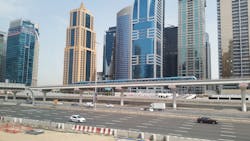By the Numbers
- Population: 2,368,452
- Area: 1,588 square miles
Dubai is the most populous city in the United Arab Emirates and is one of seven emirates in the country. It is situated on the Persian Gulf coast and surrounded by sandy desert. The summers get extremely hot, windy and humid, which can create a challenging environment.
The Roads and Transport Authority (RTA) was formed in 2005 to improve travel within Dubai. His Highness Sheikh Mohammed bin Rashid Al Maktoum , ruler of Dubai, appointed Al Tayer as the chairman of the board and executive director of the Roads and Transport Authority (RTA). The RTA oversees Strategy & Corporate Governance, Corporate & Administrative Support Services, Corporate Technical Support Services, the Public Transport Agency, the Traffic & Roads Agency, the Rail Agency, Dubai Taxi, and the Licensing Agency.
A recent press tour organized by Alstom offered a firsthand look at the RTA’s tram and provided insight to the growth and expansion of the city’s transportation network.
Vincent Prou, MD Gulf Countries with Alstom, talked of the huge growth in Dubai. There are 2.1 million inhabitants and 10 million visitors a year. While oil used to be a large source of revenue, it is now less than 5 percent and tourism is one of the largest generators.
The fast growth has created a need for strong infrastructure that can accommodate it. Dubai has a policy of investing heavily in its infrastructure, including its public transport, to improve its economic vitality. In 2014, Dubai Smart City was launched, an initiative to make the city one of the world’s most connected and sustainable cities. The mission of Dubai Smart City is “Embraces innovation to make Dubai more efficient, seamless, safe and deliver an enriched city experience through smart technology.”
In 2013 the United Arab Emirates won the right to host the World Expo in Dubai in 2020, which has also spurred infrastructure growth and development to meet those anticipated demands. World Expos last six months it is anticipated 25 million will visit Expo 2020, and many of those will arrive by the RTA Metro.
With the 2.1 billion inhabitants and 10 million visitors a year, there’s a strong will of the Emirate to increase the share of public transportation to 30 percent by 2030. Currently it is at 13 percent. To do this, the RTA will introduce new legislation to deter car drivers and spending more than 5.5 billion to build its transportation infrastructure.
By the Numbers
- Intercity Buses: 163
- Public Buses: 934
- Public Bus Routes: 103
- Ferries: 2
- Water Taxis: 5
- Water Buses: 9
- RTA Employees
- Public Transport Agency: 3,835
- Rail Agency: 148
*RTA 2013
By the Numbers
- Public Transportation Buses
- Passengers: 128,539
- Buses: 932
- Lines: 106
- Metro Passengers’ Trips
- Red Line: 104,018,269
- Green Line: 60,288,811
- Metro Stations: 47, 9 underground
- 87 Trains
- Total: 164,307,080
*Government of Dubai 2014
Regional Connection
Dubai Metro’s Red Line opened September 9, 2009 and the Green Line opened September 9, 2011. The overall length of the metro is about 44 miles and it is completely driverless by Thales Rail Signaling Solution with a minimum headway of 90 seconds. The driverless train control solution is Thales’ Seltrac communications-based train control (CBTC).
The five-car trains can accommodate more than 600 passengers and each of the give cars are split into three classes: gold class, Women and children and silver class. The metro has many safety features, including more than 3,000 CCTVs in trains and stations, a dedicated Metro Police, and an integrated radio system between the metro and emergency services.
Metro has recorded high ridership levels during the first quarter of this year; 44,371,860 riders have used the metro the first three months of this year.
The Route 2020 Project is the extension of the Red Line to the site of Expo 2020, an approximately 9 mile extension. It includes seven stations, two of which will be underground and includes a plan to construct three stations to serve Al Maktoum International Airport.
The project is going to be a design-build contract. Construction will start once the contract is awarded in the first quarter of 2016 and it is set to be completed in 2020.
While talking about the RTA tram, Vincent Prou, MD Gulf Countries with Alstom, spoke of trends in the region, including the Middle East focusing on turnkey projects. He said it is probably for two reasons. “It’s an emerging industry in this region so it’s easier with expertise and resources, to rely on experience,” he explained. “Second, I think the amount of work that is generated in the various countries is such that it would be difficult for the authorities to put people in to work on the different projects.”
A Catenary-Free Landscape
RTA’s tram is a turnkey tramway system and it is 100 percent catenary free. The project was a design-build, is 11 km long, has 11 enclosed stations, 8 traction power substations and 5 lighting power substations. The project began in 2012 and opened two months early on 11/11/14.
The trams are Alstom’s Citadis and can carry up to 408 passengers in Gold, Silver and Women & Children classes. The front nose is diamond shaped and the external livery is meant to suggest the sand dunes of the Emirates.
Prou said the request from RTA was three-fold: Performance, comfort and safety.
Alstom Transport SVP MEA Gian-Luca Erbacci said there were particular difficulties to create this project working in the difficult environment of high temperatures, low temperatures, sun and sand. In particular, protecting electronics parts in the power supply, protecting electronics from the heat, using particular ventilation to protect the components, and increasing the power of the climatization.
Prou added that there were a lot of things done to make it robust for the climate in terms of corrosion, sand, humidity and temperature. Some of which are batteries resized for higher loads; traction motor corrosion testing to 500hr; external CCTV upgraded to IP67; bogies climate tested for 55 C, special paint and corrosion testing to 1,500hr; UV-resistant cabling, electronics, and car body paint; electronic-controlled HSCB replaced with electro-mechanical control; APS brushes to remove sand and objects; and UV-protected windows with specific solar films.
Each of the platforms is fully enclosed with air-conditioned stations. “For that, you need to ensure the right accuracy in stopping in front of the doors so you can align the train doors,” said Prou. The communications-based train control allows the tram to maintain a braking curve within a very specific, accurate distance.
For catenary-free power, RTA’s tram uses Alstom’s APS ground-level power supply. Power is supplied to the vehicle through a segmented street-level power rail embedded between the running rails in the axis of the track. The conductive segments are switched off/on/off as the tram progresses, ensuring total safety for pedestrians. Prou said when the tram leaves the section, the line is safe again for cars or pedestrians.
The APS third rail is made of 8 meter-long conductive segments separated by 3-meter insulting joints. Power is supplied to the conductive segments by buried power units and the electricity transmitted through the third rail is picked up by two contact shoes located on both sides of the tram central bogie.
Conductive segments are powered underneath the vehicle only so that all segments not covered by a tram have no voltage running through them.
This system preserves the aesthetics of city centers by eliminating the need for poles and overhead catenary lines, full compatibility with all types of road and track bed surfaces and easy line extensions.
Turnkey Options
Messelyn explained the main difference between an integrated approach of a turnkey system and a traditional approach is the level of responsibility that is transferred. In a separated approach, the local authority maintains management of the project and the system and tenders multiple contracts for portions of the infrastructure for subsystems. In this case the public authority has the responsibility to integrate those subsystems while when a project is led as an integrated system, the authority maintains project supervision but outsources the whole project in one contract through one tender.
He gave several reasons why some opt for an integrated system. First is financing. Financing projects is easier when you have to finance your project through private-owned debt and have debt in one contract. With multiple tenders there are multiple financing contracts.
Project time is reduced. With a turnkey approach, there is no need to develop detailed design before tendering. “You can stick to a basic design and it’s up to the manufacturer to develop the design,” Messelyn said. “It’s quicker when they have only one tender to launch, one contract to manage.”
Costs are optimized. Messelyn said it’s a very competitive market so the solutions that are provided by the competition is optimized.
Issues have to be solved within the private sector and the agency can rely on the industry to achieve a system that is most efficient, from fleet sizing to maintainability. “With those kinds of contracts, they can focus on their core mission: to organize the public transport network,” said Messelyn.
Also driving this market is the urbanization, the importance of sustainable development and short-term budget contraints. Prou said the Middle East has been focusing on turnkey projects probably for two reasons – it’s an emerging industry in the region so it’s easier to have the expertise and resources to rely on experience and the amount of work that is generated in the various countries, it would be difficult for the authorities to put people in to work on the different projects.
Plan for the future include two more phases. Phase 2 of the tram would extend the line approximately 4 km and add 6 new stops and 14 new trams. It is expected to start sometime in 2016. Further down the road is Phase 3, which will add another 15 to 20 km running along the coast.
There is a major development at the beginning of the Phase 2 alignment called Mall of the World, which is to be the largest mall ever built. The tram will have to interface with the development so Prou said there may be reshuffling in the way the RTA will extend the tramway and that’s why they need to wait another year for it to begin.
In the first 100 days of operation, RTA reported that more than 830,000 passengers had ridden the tram. There are about 100 people working daily to maintain the network and even under heavy rain and sand storms, Prou said the system is meeting its performance measures.
Project Financing
Prou spoke of funding for the tram project and said they have seen a lot of public funding in the region. He said they have seen various countries leveraging other financing options. In Dubai, he said the government decided to benefit from extremely favorable conditions of financing with long-term profile. He said the governments of today are looking at the options of leveraging either public funds or looking at private financing, though he said they have not yet seen more elaborate schemes of public-private partnerships (P3).
RTA has worked in defining Dubai’s P3 policy framework . RTA also sees P3s as a way to introduce the private sector’s technology and innovation to the public sector.



